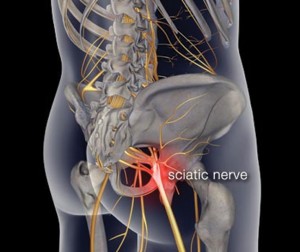By Dr. Deanna Barbaro –


Sciatica is not a death sentence but it can have a severe impact on sufferers’ daily lives and routines. Unable to sleep, simple things like walking, bending, turning and sitting or standing up may not be so simple anymore. Many people have lived with Sciatica for years on end finding no relief through traditional medicine, injections or therapy. You do not have to live with the pain, discomfort and debilitating symptoms associated with this terrible condition.
The sciatic nerve is the longest and largest nerve in your body beginning in your lower back as five smaller nerves join and extend to your pelvis, thigh, knees, calf, ankle, foot and toes. The pain and accompanying sensations may follow the path of this nerve down the legs into the feet and may even radiate into your back. Sciatica pain and symptoms may be different for each person as some experience pain in the back of the legs and others in the front and others may feel this on both legs! Sciatica pain is often so debilitating that it forces people to miss work and other normal activities. According to research, of all patients with low-back pain, sciatica patients have the highest level of disability. (1)
WHY ME?
There are a wide variety of causes and contributors to Sciatic Nerve Pain including protruded or ruptured discs. Although there may be other contributors irritating your sciatic nerve including vitamin deficiencies, spinal misalignment is the leading cause of pressure on the sciatic nerve. (2) Our nerves (including the sciatic nerve) connect and communicate to our brain through our spinal cord which is encased and protected by our spinal column. Spinal misalignment causes undue pressure on these nerves. A displaced vertebrae causing pressure on a nerve is called a “subluxation.” Sciatica has been reported following accidents, injuries and even childbirth usually due to spinal misalignment RELIEF PLEASE!
Many medical doctors seek to relieve sciatica symptoms with painkillers, muscle relaxers, traction or physical therapy however many patients have found little or no relief using these treatments. The chiropractic approach offers eliminating the cause (subluxation) rather than masking symptoms. This is achieved through a chiropractic adjustment or spinal manipulation. Through controlled trials (3,4) it has been found that a chiropractic treatment plan has saved patients from surgeries where traction and pain injections haven’t.
In one study 20 patients aged 20 – 65 with low back related leg pain were divided into three groups and given medical care, chiropractic care or steroid injections. After 12 weeks the groups that were given steroid injections and medical care showed no advantage over the chiropractic patients who experienced improvement without drugs! (5)
In 2007, a study was conducted on 44 workers hospitalized with sciatic pain in Norway. Each were adjusted by the hospital chiropractor and 91% returned to full-time work within an average of 21.1 days – a reduction on the average 72 days it takes for sciatica patients to return to work. (6)
In another study, 3,136 people with lower back and sciatica pain who had previously had physiotherapy and drugs with no positive results were given chiropractic care. A follow-up two years later showed that 50.4% had excellent results with no painful relapses, 34.4% had relapses but then responded favorably after further chiropractic care and 15.2% showed no significant improvement. (7)
THE BOTTOM LINE
The bottom line is, if you suffer from sciatica you should see a Chiropractor. Before opting for surgery, try the safe, drug-free approach. If you’ve had surgery and still have pain, you may still find relief with a Chiropractor.
Dr. Deanna Barbaro takes a very thorough approach to finding subluxation. A detailed consultation, exam and X-rays allow her to determine the best treatment plan required for each individual patient. By eliminating subluxation, her adjustments can help relieve pressure from your nerves, take stress off your discs and allow proper nerve flow ensuring your nerves transmit energy and information properly throughout your nervous system – for a happier, healthier you.
References:
(1) Arana E. Marti-Bonmati L, Vega M et al. Relationship between low back pain, disability, MR imaging findings and health care provider. Skeletal Radiology. 2006;35(9):641-647
(2) Fonti S, Lynch M. Etiopathogenesis of lumbosciatalgia due to disc disease; chiropractic treatment. In J. Mazzarelli (Ed.), Chiropractic: Interprofessional Research. Torino, Italy: Edizioni Minerve Medica, 1983:59-68
(3) Mathews JA et al. Back pain and sciatica: controlled trials of manipulation, traction, sclerosant and epidural injections. British Journal of Rheumatology. 1987;26:416-423
(4) Cox JM, Shreiner S. Chiropractic manipulation in low back pain and sciatica: statistic data on the diagnosis, treatment and response of 576 consecutive cases. JMPT. 1982; 7-11.
(5) Bronfort G et al. Non-operative treatments for sciatica: a pilot study for a randomized clinical trial. JMPT. 2000;23(8):536-544
(6) Orlin JR, Didriksen A. Results of chiropractic treatment of lumbopelvic fixation in 44 patients admitted to an orthopedic department. JMPT. 2007;30:135-139
(7) Downs S. Unilateral intermittent claudication of the left lower extremity. JMPT. 1988;11:322-324
 Southwest Florida's Health and Wellness Magazine Health and Wellness Articles
Southwest Florida's Health and Wellness Magazine Health and Wellness Articles
